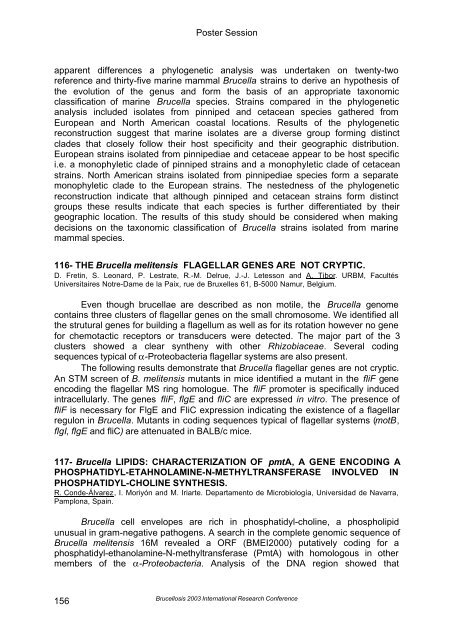Brucellosis 2003 proceedings - PHIDIAS
Brucellosis 2003 proceedings - PHIDIAS
Brucellosis 2003 proceedings - PHIDIAS
You also want an ePaper? Increase the reach of your titles
YUMPU automatically turns print PDFs into web optimized ePapers that Google loves.
Poster Session<br />
apparent differences a phylogenetic analysis was undertaken on twenty-two<br />
reference and thirty-five marine mammal Brucella strains to derive an hypothesis of<br />
the evolution of the genus and form the basis of an appropriate taxonomic<br />
classification of marine Brucella species. Strains compared in the phylogenetic<br />
analysis included isolates from pinniped and cetacean species gathered from<br />
European and North American coastal locations. Results of the phylogenetic<br />
reconstruction suggest that marine isolates are a diverse group forming distinct<br />
clades that closely follow their host specificity and their geographic distribution.<br />
European strains isolated from pinnipediae and cetaceae appear to be host specific<br />
i.e. a monophyletic clade of pinniped strains and a monophyletic clade of cetacean<br />
strains. North American strains isolated from pinnipediae species form a separate<br />
monophyletic clade to the European strains. The nestedness of the phylogenetic<br />
reconstruction indicate that although pinniped and cetacean strains form distinct<br />
groups these results indicate that each species is further differentiated by their<br />
geographic location. The results of this study should be considered when making<br />
decisions on the taxonomic classification of Brucella strains isolated from marine<br />
mammal species.<br />
116- THE Brucella melitensis FLAGELLAR GENES ARE NOT CRYPTIC.<br />
D. Fretin, S. Leonard, P. Lestrate, R.-M. Delrue, J.-J. Letesson and A. Tibor. URBM, Facultés<br />
Universitaires Notre-Dame de la Paix, rue de Bruxelles 61, B-5000 Namur, Belgium.<br />
Even though brucellae are described as non motile, the Brucella genome<br />
contains three clusters of flagellar genes on the small chromosome. We identified all<br />
the strutural genes for building a flagellum as well as for its rotation however no gene<br />
for chemotactic receptors or transducers were detected. The major part of the 3<br />
clusters showed a clear syntheny with other Rhizobiaceae. Several coding<br />
sequences typical of α-Proteobacteria flagellar systems are also present.<br />
The following results demonstrate that Brucella flagellar genes are not cryptic.<br />
An STM screen of B. melitensis mutants in mice identified a mutant in the fliF gene<br />
encoding the flagellar MS ring homologue. The fliF promoter is specifically induced<br />
intracellularly. The genes fliF, flgE and fliC are expressed in vitro. The presence of<br />
fliF is necessary for FlgE and FliC expression indicating the existence of a flagellar<br />
regulon in Brucella. Mutants in coding sequences typical of flagellar systems (motB,<br />
flgI, flgE and fliC) are attenuated in BALB/c mice.<br />
117- Brucella LIPIDS: CHARACTERIZATION OF pmtA, A GENE ENCODING A<br />
PHOSPHATIDYL-ETAHNOLAMINE-N-METHYLTRANSFERASE INVOLVED IN<br />
PHOSPHATIDYL-CHOLINE SYNTHESIS.<br />
R. Conde-Álvarez, I. Moriyón and M. Iriarte. Departamento de Microbiología, Universidad de Navarra,<br />
Pamplona, Spain.<br />
Brucella cell envelopes are rich in phosphatidyl-choline, a phospholipid<br />
unusual in gram-negative pathogens. A search in the complete genomic sequence of<br />
Brucella melitensis 16M revealed a ORF (BMEI2000) putatively coding for a<br />
phosphatidyl-ethanolamine-N-methyltransferase (PmtA) with homologous in other<br />
members of the α-Proteobacteria. Analysis of the DNA region showed that<br />
156<br />
<strong>Brucellosis</strong> <strong>2003</strong> International Research Conference
















